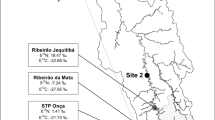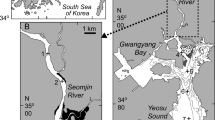Abstract
We examined how nitrogen-stable isotopic signatures of food web components (basal resources, primary and lower consumers, and omnivores) in rivers change with increasing levels of human population density (HPD) in their watersheds. Samples were collected from 22 rivers flowing in the Lake Biwa basin, Japan. Among three potential resources at the base of food webs (epilithon, benthic and suspended particulate organic matter), the mean isotopic values (δ15N) of the epilithon (4.5–7.8%) were consistently higher than those of other items (1.9–4.2%) and displayed the most pronounced elevation (by 3.3%) with increasing HPD. The mean δ15N values of the individual taxa of lower consumers (bivalve, snail and caddisfly) tended to increase with increasing HPD, although the pattern and the extent of the elevation were highly variable among the taxa. These results suggest a taxon-specific feature in the N source (or sources) of lower consumers. Our data suggested that human activities (e.g. nutrient loading) potentially induce changes in the N baselines of river food webs. The major N source of bivalves appeared to be shifted from suspended particulate organic matter to other items with increasing HPD. Trophic levels of goby fish (Rhinogobius sp. OR) and shrimp (Palaemon paucidens), being estimated to be at 2.4–3.8 and 2.1–3.4, respectively, did not differ significantly among rivers with different HPD levels.



Similar content being viewed by others
References
Anderson C, Cabana G (2005) δ15N in riverine food webs: effects of N inputs from agricultural watersheds. Can J Fish Aquat Sci 62:333–340
Cabana G, Rasmussen JB (1996) Comparison of aquatic food chains using nitrogen isotopes. Proc Natl Acad Sci USA 93:10844–10847
Chikaraishi Y, Kashiyama Y, Ogawa NO, Kitazato H, Ohkouchi N (2007) Metabolic control of nitrogen isotope composition of amino acids in macroalgae and gastropods: implications for aquatic food web studies. Mar Ecol Prog Ser 342:85–90
Doi H, Takemon Y, Ohta T, Ishida Y, Kikuchi E (2007) Effects of reach-scale canopy cover on trophic pathways of caddisfly larvae in a Japanese mountain stream. Mar Freshw Res 58:811–817
Finlay JC (2001) Stable-carbon-isotope ratios of river biota: implications for energy flow in lotic food webs. Ecology 82:1052–1064
Finlay JC, Khandwala S, Power ME (2002) Spatial scales of carbon flow in a river food web. Ecology 83:1845–1859
Fry B (1991) Stable isotope diagrams of freshwater food webs. Ecology 72:2293–2297
Heaton THE (1986) Isotopic studies of nitrogen pollution in the hydrosphere and atmosphere: a review. Chem Geol 59:87–102
Jones RI, King L, Dent MM, Maberly SC, Gibson CE (2004) Nitrogen stable isotope ratios in surface sediments, epilithon and macrophytes from upland lakes with differing nutrient status. Freshw Biol 49:382–391
Kendall C, McDonnell JJ (1998) Isotope tracers in catchment hydrology, 1st edn. Elsevier, New York
Kryger J, Riisgård HU (1988) Filtration rate capacities in 6 species of European freshwater bivalves. Oecologia 77:34–38
Lake JL, McKinney RA, Osterman FA, Pruell RJ, Kiddon J, Ryba SA, Libby AD (2001) Stable nitrogen isotopes as indicators of anthropogenic activities in small freshwater systems. Can J Fish Aquat Sci 58:870–878
Liess A, Hillebrand H (2006) Role of nutrient supply in grazer–periphyton interactions: reciprocal influences of periphyton and grazer nutrient stoichiometry. J North Am Benthol Soc 25:632–642
Maruyama A, Yamada Y, Yuma M, Rusuwa B (2001) Stable nitrogen and carbon isotope ratios as migration tracers of a landlocked goby, Rhinogobius sp. (the orange form), in the Lake Biwa water system. Ecol Res 16:697–703
McClelland JW, Montoya JP (2002) Trophic relationships and the nitrogen isotopic composition of amino acids in plankton. Ecology 83:2173–2180
Ministry of Land Infrastructure and Transport (1997) Digital national land information, Japan
Ministry of Internal Affairs and Communications (2000) Population census, Statistics Bureau, Japan
Post DM (2002) Using stable isotopes to estimate trophic position: models, methods, and assumptions. Ecology 83:703–718
Post DM, Pace ML, Hairston NG Jr (2000) Ecosystem size determines food-chain length in lakes. Nature 405:1047–1049
Shiga Prefectural Government (2000) Watershed map of Shiga prefecture, Japan
Silliman BR, van de Koppel J, Bertness MD, Stanton LE, Mendelssohn IA (2005) Drought, snails, and large-scale die-off of southern U.S. salt marshes. Science 310:1803–1806
Tucker J, Sheats N, Giblin AE, Hopkinson CS, Montoya JP (1999) Using stable isotopes to trace sewage-derived material through Boston Harbor and Massachusetts Bay. Mar Environ Res 48:353–375
Vander Zanden MJ, Rasmussen JB (1999) Primary consumer δ13C and δ15N and the trophic position of aquatic consumers. Ecology 80:1395–1404
Woodward G, Hildrew AG (2002) Food web structure in riverine landscapes. Freshw Biol 47:777–798
Wotton RS, Malmqvist B, Leonardsson K (2003) Expanding traditional views on suspension feeders—quantifying their role as ecosystem engineers. Oikos 101:441–443
Acknowledgments
We thank N. Okuda and T. Miyajima for their useful comments on the manuscript. This study was supported by the Research Project 3-1 of the Research Institute for Humanity and Nature and the Basic Research Program (CREST-type strategic sector, R and D of Hydrological Modelling and Water Resources System) of the Japan Science and Technology Agency.
Author information
Authors and Affiliations
Corresponding author
Additional information
An erratum to this article can be found at http://dx.doi.org/10.1007/s11284-008-0517-x
Appendix
Appendix
The data gathered from the 22 study rivers flowing in the Lake Biwa basin, Japan are shown in Table 4.
About this article
Cite this article
Kohzu, A., Tayasu, I., Yoshimizu, C. et al. Nitrogen-stable isotopic signatures of basal food items, primary consumers and omnivores in rivers with different levels of human impact. Ecol Res 24, 127–136 (2009). https://doi.org/10.1007/s11284-008-0489-x
Received:
Accepted:
Published:
Issue Date:
DOI: https://doi.org/10.1007/s11284-008-0489-x




